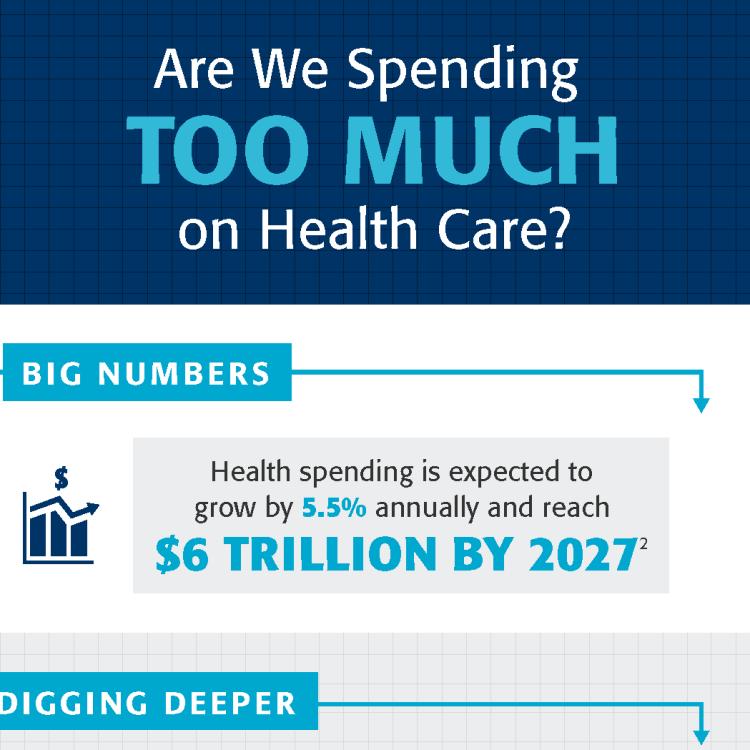A Health Podyssey | Episode 93
Listen in as Marcia Weaver from the University of Washington joins Health Affairs Editor-in-Chief Alan Weil to discuss whether we receive value for our high levels of health spending.
Authors
Marcia R Weaver, PhD, Joseph Dieleman, PhD, Jonah Joffe, MS, Christopher JL Murray, DPhil Arjun Singh, MS, Gianna W Sparks, BA, Lauryn Stafford, BA/BS, Institute for Health Metrics and Evaluation, University of Washington; Michael Ciarametaro, MBA, and Robert Dubois, PhD, National Pharmaceutical Council; Abe Dunn, PhD, Bureau of Economic Analysis, U.S. Bureau of Commerce
Publication
Health Affairs, July 5, 2022
Continued increases in health care spending are a growing concern for policymakers. At the same time, reducing disability and early death is of priority for society, patients, and policymakers. These counterbalancing priorities create a critical policy question: whether the gains in health, as measured by the reduction of death and disability, justify the additional dollars spent on health care. A new study in Health Affairs by researchers from the National Pharmaceutical Council (NPC) and the University of Washington addresses this policy question.
Researchers assessed the value of U.S. health care spending increases by comparing changes in spending to differences in health outcomes over time. Researchers used data on disability-adjusted life-years (DALYs) to determine changes in health outcomes for 139 causes from 1996 to 2016. Contrary to public perception, empirical results show that: (1) Increased healthcare spending is a source of high value for patients and society (2) The costs of improving health are declining with time.
Key Findings
- Increased U.S. health spending has been a source of high value to society and patients. The U.S. spent an average of $114,339 in total health care costs per DALY averted across all disease causes from 1996 to 2016. The cost per unit of improved health is well below the generally accepted standard of three times GDP. Efforts to curtail health spending need to consider trade-offs associated with reducing this high-value investment.
- U.S. healthcare purchasing power has increased with time; in other words, the costs of improved health are declining with time. The cost of averting a disability-adjusted life-year fell by 13% from 1996 to 2016, using $150,000 as the dollar value per DALY averted. The researchers created an outcome-adjusted health care price index to compare prices today for a given basket of goods and services with prices in the past for the same basket (e.g., the ratio of spending in 2016 to spending in 1996, in which spending in 1996 is adjusted by adding the dollar value of additional DALYs averted in 2016).
- The value of health care spending increases varied substantially across causes. The value of health spending increases varied significantly across the 41 causes with high spending and/or high burden. Some of these differences are attributable to shortcomings in measuring changes in disability over time, which suggests improvements in disability measurement are needed. While some of the differences are attributable to method shortcomings, the significant variations in value suggest a one size fits all approach to health care may not be appropriate.
Methods
Researchers used the Disease Expenditure Study (DEX) for spending data by cause and the Global Burden of Disease Study (GBD) for data on disability-adjusted life-years (DALY) for 139 causes from 1996 to 2016. The study decomposed changes over time to estimate spending per case and DALYs averted per case, controlling for changes in population size, age-sex structure, and incidence or prevalence of cases. Researchers then calculated an outcome-adjusted health-care price index by assigning a dollar value to DALYs averted per case.
Limitations
When breaking down the numbers by cause, conditions where the burden is primarily patient disability as opposed to patient fatality, spending effectiveness was less favorable. This is likely because changes in DALYS per case may be underestimated for some causes, especially non-fatal causes. Disease burden was predominantly fatal for 21 of the 41 causes with high burden and/or spending.
A Growing Body of Research
|
This study is the latest in NPC’s Bang for the Buck research series investigating the impact of health spending and its effects on patient health and life expectancy. Prior studies in our Bang for the Buck research series showed that spending on innovation in health care generally, and pharmaceuticals specifically, contributes to greater years of quality life lived and longer lives overall. Across eight previously studied conditions, pharmaceuticals and biopharmaceuticals were the single largest driver of health improvement. It’s important to understand that the benefits of innovation are not uniform, but the results do indicate areas of high-value care. For more information on prior Bang for the Buck studies investigating the impact of health spending on patient health and life expectancy, watch this webinar on-demand. |




